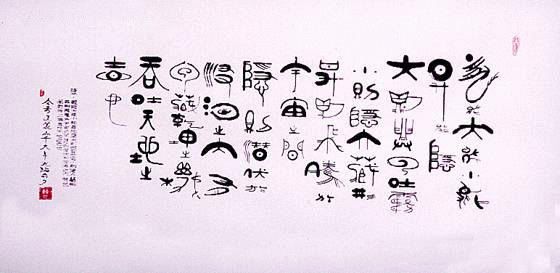|
 
- 积分
- 8202
- 威望
- 3197
- 金钱
- 0
- 阅读权限
- 90
- 在线时间
- 173 小时
|
2#
 发表于 2008-9-24 09:28
发表于 2008-9-24 09:28
| 只看该作者

『英语杂谈』狼和蒙古人(《狼图腾》英文版书评中文译文)
作者:白马书院 提交日期:2008-6-22 20:31:00
Wolves and other Mongolians
CHARLES FORAN
June 14, 2008
WOLF TOTEM
By Jiang Rong
Translated by Howard Goldblatt
Penguin, 527 pages, $26.95
Wolf Totem is indeed a novel about wolves. A sprawling novel, too, deeply learned about its subject. A publishing phenomenon in China when it first appeared in 2004, and recent inaugural winner of the Man Asian Literary Prize, the book is also about the fragile culture of the Chinese-controlled "Inner Mongolian Autonomous Region," the grassland and mountain zone abutting the neighbouring nations of Mongolia and Russia. About this subject as well, it is no less exhaustive.
If Wolf Totem marginalizes anything, it is what Chinese readers must have originally expected to occupy the centre of the story: the adventures of students sent to Mongolia in 1969 during the Cultural Revolution. The narrative is a familiar one in contemporary Chinese fiction. Most often cast as a bittersweet coming-of-age story - during the Cultural Revolution, millions of students and intellectuals were sent to the countryside to "learn from the peasants" - such settings are generally backdrops for tales of lost love and youth, the melancholy of vanished innocence.
The novel is having little of this, either. Along with his friend Yang Ke, young Beijing intellectual Chen Zhen does escape the lunacy of the capital and lives with Mongolian nomads for three years, seeking a spirituality he expects to locate in the reading materials he has brought along. He also makes the obligatory return decades later to the site of the experience that so shaped him. There he confronts the disappearance of the way of life he had come to admire.
Otherwise, though, Wolf Totem, written by the pseudonymous Jiang Rong, a retired Beijing professor who volunteered to work in Inner Mongolia at the age of 21 and wound up living there for 11 years, is indifferent to the inner feelings and back stories of its Han characters. Instead, the novel is a quasi-anthropological study of, and literary paean to, Mongolian nomads and their great allies/enemies, the fearsome wolves.
It is likewise a roaring adventure, replete with epic battle scenes that cross Leo Tolstoy and Jack London, with the spirit of Genghis Khan - himself a student of lupine war tactics - looking down. That many of those battles are between wolves and gazelles, or wolves and horses, in no way diminishes their grandeur.
Quite the opposite: The spirituality Chen ultimately discovers is rooted in the balance of man, animal and earth. Mongolians revere wolves, making them totems. Elders understand that the pitiless landscape they inhabit requires balance to ensure survival. "Out here," the Mongolian Bilgee explains, "the grass and grassland are the life, the big life. All else is little life that depends on the big life for survival."
Wolves are "little life." But so are humans. "Big life" is the totality, bannered under the godhead known as Tengger. Early inhabitants of the Central Asian plateau believed they were actually descended from white dogs. "The ancestors of the Huns, the Gaoju, and the Turks were wolf children," a character remarks, "all raised by wolf mothers." More pointedly, Bilgee takes pains to undermine Chen’s view of "man as the primary element."
Substitute "man" with "Han," as in Han-Chinese, and the outline of a parable about China and its empire begins to emerge. For a novel published and celebrated in mainland China without its author ending up - to date, at least - in trouble, Wolf Totem has a bold heart.
The parable is left largely explicit, aside from a few digs at the absurdity of Maoist doggerel ("Wolves are the true class enemies!" shouts one Red Guard) and an intriguing reference near the end to the great modernist Lu Xun’s theme of the ceaseless struggle within Chinese society to probe its national characteristics honestly. "We Chinese seem incapable of ridding ourselves of that flaw," a character says of the habit of using things up until they are forever gone.
For the rest, Wolf Totem counts on its Moby-Dick-like chronicling of the phenomenological details of Mongolia - an elemental world eradicated by the colonization of the grasslands in the 1970s and ’80s, reducing much of the region to desert - to make its point about how other people and other cultures exist inside China, whether or not that "otherness" goes acknowledged, let alone respected. A movie is apparently being made of the book, aimed to coincide with this summer’s Olympics.
Coincidentally, the Chinese empire is back in the news. The Western media seem shocked by how possessive Beijing feels toward Tibet. Like its similarly strong feelings for the "breakaway province" of Taiwan, the "internal matter" of Tibet is a bracing reminder that China isn’t a country. It is a collection of 56 nationalities, overseen by the dominant Han group.
How this dynamic gets expressed is rarely "real" to outsiders. But anyone with the misfortune of belonging to one of those other 55 nationalities finds the dynamics only too real, and too rarely self-examined. As one China watcher put it, with respect to the certainty that the opening ceremony of the Beijing Games will involve much ersatz singing and dancing by Tibetans with painted-on smiles, Han Chinese firmly believe that everyone in China, except for themselves, are crazy about folkloric dances in colourful costumes. It is a small example of how non-Han cultures are debased, the better to conquer, then assimilate, and then vanish them.
Wolf Totem may not be the most accomplished of novels - Jiang Rong has more passion and vision than style - but if Chinese readers, either now or later, are able to see clear to his fable of engagement with the "others" that share, whether by consent or force, the massive and diverse geographical entity known as the People’s Republic of China, it will serve as a cultural benchmark. Such an engagement, after all, would amount to no less than a revolution - albeit, a quiet (and real) one.
Contributing reviewer Charles Foran’s new book is Join the Revolution, Comrade.
http://www.theglobeandmail.com/s ... Entertainment/Books
狼和蒙古人
查尔斯.弗伦
(原著:姜戎。英文版本翻译:霍华德.金布莱特。企鹅出版)
《狼图腾》是一部真正描写狼的小说。如果我们深入探究小说的主题,它还是一部寓意深远的小说。2004年首次出版即成为畅销书,亦是首届亚洲人文学奖的得主,《狼图腾》主要描述了汉人控制下的内蒙古自治区脆弱的民族文化,内蒙古自治区是与俄罗斯和蒙古民主共和国接壤的一大片草地和群山。就这部分的主题而言,《狼图腾》是非常彻底的。
如果《狼图腾》淡化了什么,那就是中国读者开始读这部小说期待的故事焦点:1969年,文化大革命,下乡知识青年在内蒙古自治区的遭遇。这种题材在中国当代文坛中已经屡见不鲜。作者惯用的写作模式是回忆青年时代的辛酸经历—文化大革命中,数以百万计的学生和青年知识分子被下放到农村去“向农民学习“—这样的场面通常是一种故事背景,去述说逝去的爱和青春,湮没了天真的伤感。
这部小说鲜有这样的伤感。北京知识青年陈阵和朋友杨可,逃离了当时首都北京近似疯狂的社会现实,来到内蒙古自治区,和蒙古族人在一起生活了3年,试图从自己随身携带的书籍中寻找灵性。在若干年之后,他返回了那曾经塑造过自己的地方,结果发现使他魂牵梦绕的那种生活方式几乎已经消失殆尽。
另外,尽管作者姜戎(笔名,某大学研究所退休)21岁时作为知识青年就志愿下放到内蒙古自治区,并最终在那里生活了11年,但《狼图腾》对作者的内在情感和和其汉民族特点的故事背景却着墨不多。相反,这部小说从某种程度上可是说是一部人类学研究专著,一首文学赞歌,对象是蒙古游牧民族和他们敬畏的朋友和敌人—狼。
同样地,《狼图腾》也是一部场面恢宏的历险记,里面有堪比列夫.托尔斯泰和杰克.伦敦笔下战争场面的史诗般的战斗,闪耀着连具有狼性战争艺术的成吉思汗也刮目相看的精神。那些狼群和瞪羚群,狼群和马群之间的战斗场面和史上著名的人类战争场面相比,毫不逊色。
颇具戏剧性效果的是,陈阵最终发现的灵性却植根于人类、动物和地球之间的平衡之中。蒙古人尊崇狼为他们的图腾。上了年纪的蒙古人都知道他们居住的自然环境残酷的地区需要某种平衡来确保生存。毕格力老人说“在那儿,草和草原是生命,大生命。其他的都是小生命,依靠大生命才生存。”
狼是“小生命”,然而人也是小生命。“大生命”是根,存在于神腾格里那里。中亚高原的早期住民相信他们的共同祖先是白犬。有人说过:“汉族人,高勾人,土耳其人的祖先都是狼的子女,由狼母抚育的。”毕格力老人更是直截了当地否定了陈阵的“人类至上”的观点。
汉人成为中国人的代称,和有关中华帝国起源传说的轮廓,开始初见端倪。在时下的中国,作者写这样一部颇具争议性的小说没有带来麻烦,至少目前还没有,《狼图腾》作者的勇气由此可略见一斑。
除了对中国前领袖毛泽东的语录(即:狼是真正的阶级敌人—红卫兵语)进行了讥讽,也对中国现代先驱鲁迅从中国人内斗的主题中探寻民族特性也进行了借鉴,这部小说的寓意可谓一针见血。一个主人公在谈到中国人有杀鸡取卵的习惯时候说:“我们中国人似乎永远也去除不了那种劣根性。”
除此之外,《狼图腾》作者期望通过小说有如《白鲸记》一般的蒙古地质编年史的记述,即20世纪70年代和80年代的大规模毁草垦殖把水草丰美的草原变成了沙漠,来强调少数民族及其文化在中国的现状,不管少数民族承认现实有否,更不用说受到尊重了。在今年的奥运会期间,根据这部小说改编的电影有望上映,绝非偶然。
巧合的是,中华帝国现在又是世界瞩目的焦点。西方媒体震惊于中国政府对西藏的强烈的占有欲。和对“分离出去”的台湾省的强烈感觉一样,西藏问题是中国的“内政”时刻提醒着世人,中国不是一个国家,而是一个汉族统治下的56个民族的集合体。
对外人来说,这种激情表达地异乎寻常得真实。但是少数民族发现这种激情过于真实了,而且乏于自省。正如一位中国研究专家指出的,可以确信,北京2008奥运会开幕式上,会有藏族人强颜欢笑,载歌载舞,而汉族人深信,在中国,除了汉族人,少数民族人民都喜欢身着艳丽民族服饰,跳民族舞蹈。这只是少数民族文化受到歧视的一个实例,(汉族人认为)最好的办法是去征服(少数民族),然后同化,然后让他们消失。
《狼图腾》可能不是最成功的小说,因为姜戎先生倾注在里面更多的是激情和想象,而非作品风格。假如中国读者,或早或晚,能够洞悉到“融合”的寓意,意即不论少数民族自愿或被迫与汉民族“融合”在庞大的中华人民共和国的版图内,这部小说将是一个新的文化基点。这种融合,归根结底,将会演变成一种温和的革命,尽管是静悄悄的(而且是真实的)革命。
(文中的观点,译者只是照译,并非表示赞同)
2008.6.14
原文作者所属博客:江湖 |
|










